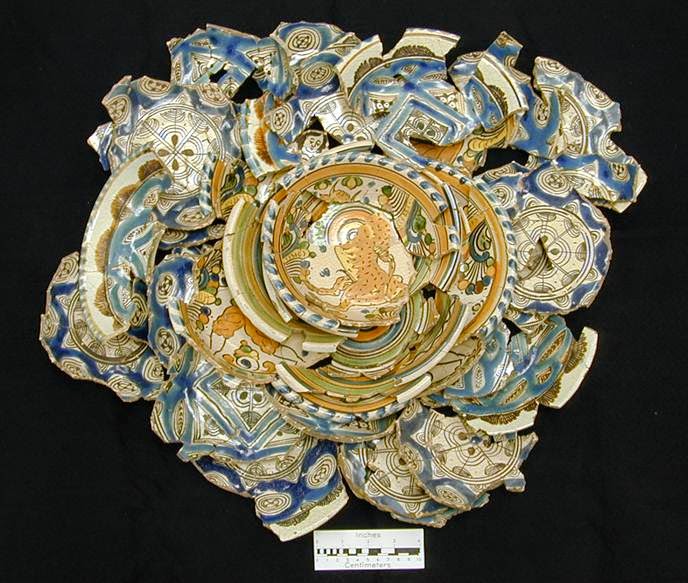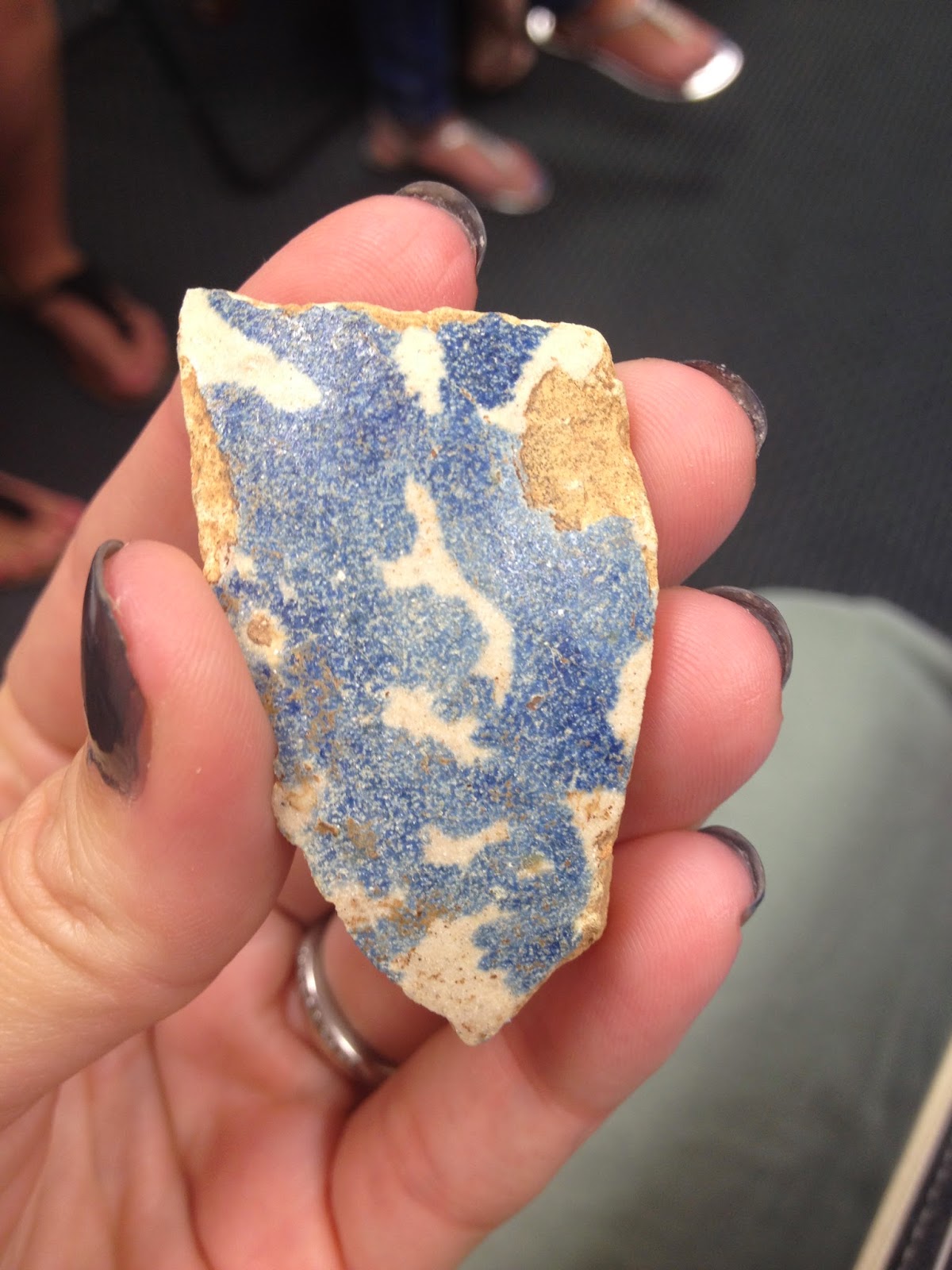Ceramics 101: Majolica- Morisco Tradition
Day 4: Majolica! Part 1 of 10* (kidding, not kidding)
So exciting you guys, this was the reason I started the #ceramics101 blog. Moving to Florida from Kentucky I was curious, intimidated, and awestruck by the alien specimens. To gain familiarity I leaned back on an old grad school trick: flashcards. I made up at least 100 of these (and by I, I mean intern Matt Armstrong) and began to flip through them day and night. Cards are good, but looking at real sherds with Kathy Deagan was a dream come true.
TO THE SHERDS!!!!
MAJOLICA is in the family of tin enameled coarse earthenwares. Tin is added to the glaze to make it opaque and is not as tightly bonded to the paste as later lead glaze. The French made tin enameled coarse earthenware, called faience. The English made tin enameled coarse earthenware, called Delft. The Spanish version is of course called Majolica. Spanish majolica can have reddish or white paste, not
sandy, but a smooth thick soft paste. It's chalky to the point you can almost write with it. Decorative
traditions, shapes and motifs, reflect cultural and national changes.



Columbia Plain plato fragment images from class.
Columbia Plain Green Dipped sherd and side view images.
 |
| Mother load of majolica (Bense 2003). |
TO THE SHERDS!!!!
 |
| Ceramics nerd girl! |
Morisco Wares were made during the time of Morisco expulsion, Muslims forced to convert to Christianity or leave the Iberian Peninsula, in the late 15th century. Morisco wares have thick bodies, pinkish cream
paste, smooth not tempered. Not really
shiny, glossy but matte surface. Vessel forms vary but the most iconic form is the escudilla, a high shouldered bowl. Platos are also commonly found, a broad, shallow saucer with curved base. Morisco wares can be further identified by how decoration was applied.
This is the stuff Columbus brought over in 1492. This is the stuff
found on the very earliest Spanish Colonial sites in the Caribbean and
the Americas. Like other Morisco wares the paste is soft, chalky
in texture and light cream to buff color. The glaze over the paste is
irregular, varies from thin to thick, from shiny to smooth.
This is the base of all Morisco wares, so if it's plain, it's Columbia Plain. If it's green, it's Columbia Plain Green Dipped. If it has a gunmetal gray tint to it, it's Columbia Plain Gunmetal. If it has blue or purple painted on in, then you have more decisions to make.



Columbia Plain plato fragment images from class.
Columbia Plain Green Dipped sherd and side view images.
Isabela is one of my absolutely favorite types. I love it so much, I made a manicure inspired by the color and design elements. Isabela has the same base paste as Columbia and features the twin blue bands on rim and base like Yayal, but the addition of purple glaze is a dead giveaway. It's the only polychrome Morisco ware and the only historic majolica to feature the color purple. The designs can be floral, abstract, and geometric. I sometimes confuse it with Yayal or Santo Domingo when I don't recognize the blackish schmear on the rim is not tar, but actually think purple glaze. But generally it's easy to pick out.
Another reason to love Isabela? Vessels often feature Alafias, common Arabic sayings, on the rims. According to the FLMNH page the Alafias commonly translate to mercy, pardon, pity, or well-being. A great cultural connection to 16th century Muslim traditions and changes in Spain from a single sherd.
No type is more fun to say than Yayal (YAYAL, ya'll!). Blue stripe bands are applied on basic Colombia plain body on both the rim and the center. Additional squiggly lines can also be applied. I found it interesting this type is named after El Yayal, Cuba where it was first identified and named.
 |
| Yayal sherds featuring blue bands and squiggly lines image from class. |
Santo Domingo features blue glaze designs over most of the vessel. Forms include bowl, jars, platos, and interestingly pitchers and jugs. Kathy likened the squiggly lines to finger painting. They almost have a form you can describe (floral, geometric) but are a bit irregular. I confuse some sherds with Yayal, seems a fine line (no pun intended) between blue banded with other squiggles (Yayal) and squiggles and shapes sometimes featuring bands (Santo Domingo). Santo Domingo was made in Seville so the paste may be a little pinker than the chalky, spongy white of Yayal. The blue can also be foamier (Kathy's word for it) and cruder.
 |
| Santo Domingo sherd images from class. |
It's safe to say this is the rarest of rare Moriscos. The only place Santa Elena has been found outside St. Augustine and Spain is where it was first discovered, at Menendez's Santa Elena settlement (1566-1587) near present day Parris Island. The mottled blue sponged decoration covers much of the vessel, more likely to be a pitcher or heavy-bodied utilitarian forms. It's interesting the FLMNH type collection has four sherds: one from the Ximenez-Fatio House in St. Augustine, one from Spain, and two from the Canary Islands.
 |
| The only Santa Elena sherd I've ever held, image from class. |
Check back next time for Part 2 (MAJOLICA: Italianates)
Other posts in the #ceramics101 series (will provide link as they are posted):
Week 1 - introduction
Week 2 - Unglazed and coarse earthenware: Part 1 Prehistoric; Part 2 Olive Jars; Part 3 European
Week 3 - Slipware and lead-glazed pottery
Week 4 - Majolica- Morisco tradition
Week 5 - Majolica- Italianate tradition
Week 6 - Majolica- Mexico City tradition
Week 7 - Majolica- Puebla tradition
Week 8 - Delft & Faience
Week 9 - Porcelain
Week 10 - Refined Earthenware
Week 11 - Stoneware
Text and images: Sarah Miller, FPAN staff using notes from Dr. Deagan's Fall 2012 Historic Ceramic Analysis class at Flagler College. Majolica mother load thumbnail from Judy Bense's Presidio Santa Maria de Galve (UPF 2003). Please note any errors and inaccuracies are mine. Endless thanks to Dr. Kathleen Deagan to giving her blessing to this blog project last year.
Other posts in the #ceramics101 series (will provide link as they are posted):
Week 1 - introduction
Week 2 - Unglazed and coarse earthenware: Part 1 Prehistoric; Part 2 Olive Jars; Part 3 European
Week 3 - Slipware and lead-glazed pottery
Week 4 - Majolica- Morisco tradition
Week 5 - Majolica- Italianate tradition
Week 6 - Majolica- Mexico City tradition
Week 7 - Majolica- Puebla tradition
Week 8 - Delft & Faience
Week 9 - Porcelain
Week 10 - Refined Earthenware
Week 11 - Stoneware
Text and images: Sarah Miller, FPAN staff using notes from Dr. Deagan's Fall 2012 Historic Ceramic Analysis class at Flagler College. Majolica mother load thumbnail from Judy Bense's Presidio Santa Maria de Galve (UPF 2003). Please note any errors and inaccuracies are mine. Endless thanks to Dr. Kathleen Deagan to giving her blessing to this blog project last year.
References
Florida Museum of Natural History, Digital Type Collection, Historical Archaeology (http://www.flmnh.ufl.edu/histarch/gallery_types/)
Deagan, K. A. 2002 Artifacts of the Spanish Colonies of Florida and the Caribbean 1500-1800.Volume 1: Ceramics and Glassware. Washington: Smithsonian Institution Press (Volume 1).
Florida Museum of Natural History, Digital Type Collection, Historical Archaeology (http://www.flmnh.ufl.edu/histarch/gallery_types/)
Deagan, K. A. 2002 Artifacts of the Spanish Colonies of Florida and the Caribbean 1500-1800.Volume 1: Ceramics and Glassware. Washington: Smithsonian Institution Press (Volume 1).


